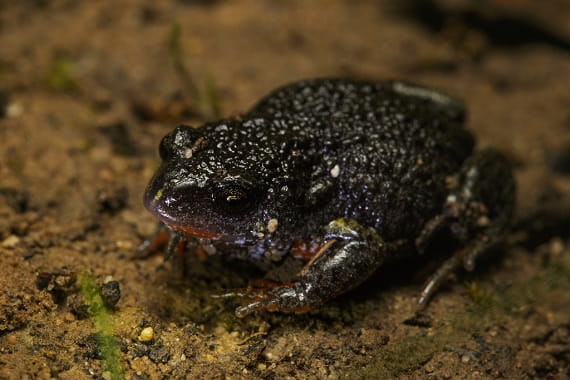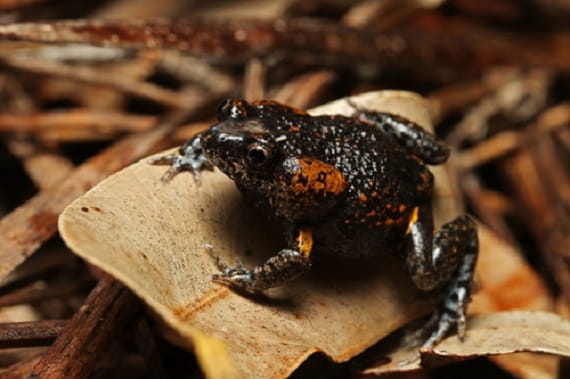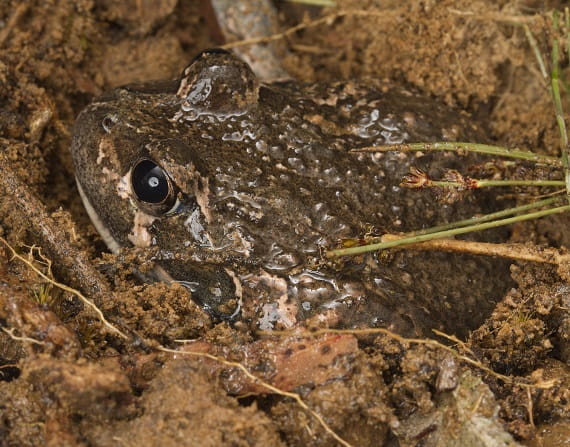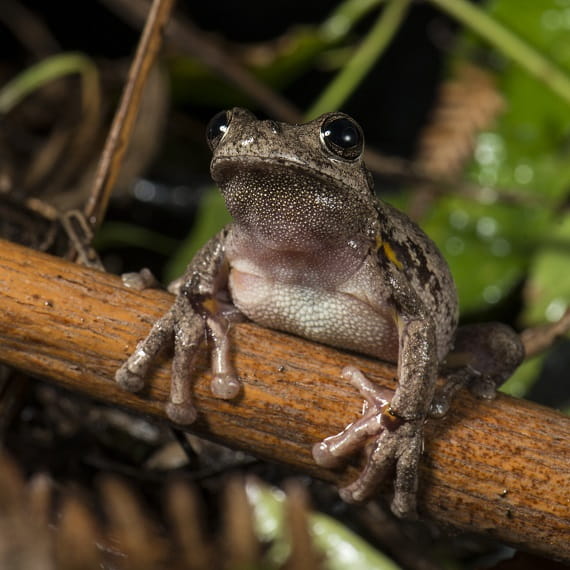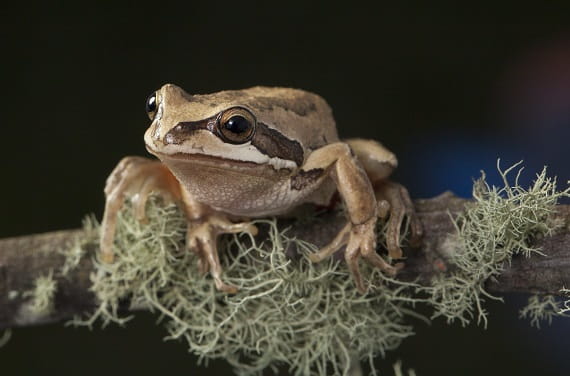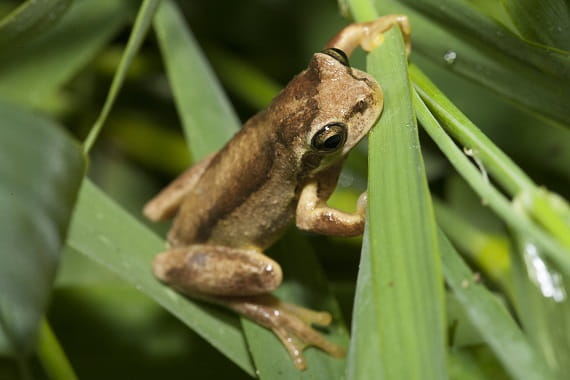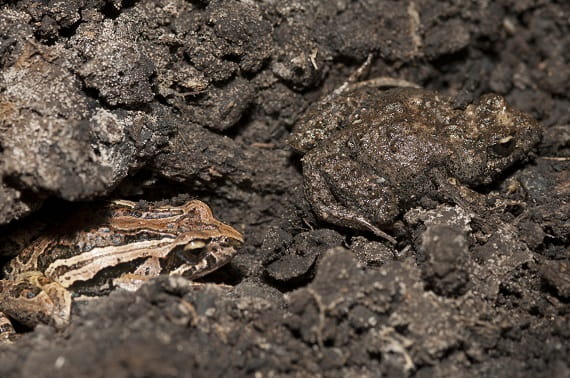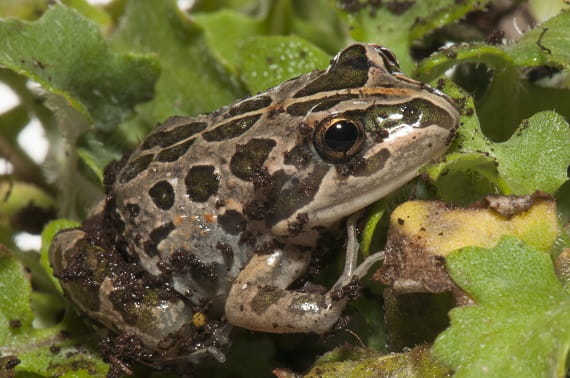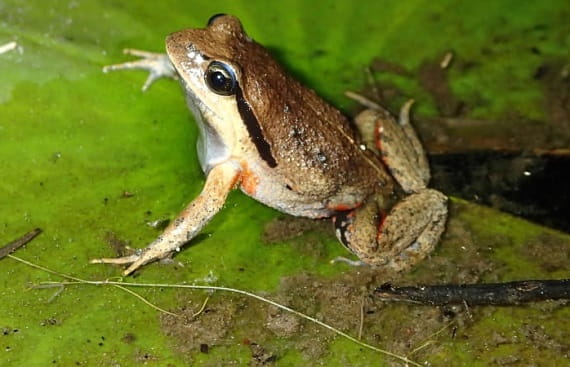Picture this - it's a warm summer night, you're in your gumboots, mozzie repellent on, standing on the muddy banks of a big pond. Your torch is switched off, the stars light up the sky and give a soft glow to the water, grasses and trees surrounding you.
The air is still.
The deafening chorus of ribbits, croaks and 'bonks' of frogs fills the night.
Over four nights in 2022, from dusk until around 2.30am, Parks Victoria staff and volunteers stood in the scrub and wetlands with their phones in their hands, recording frog calls in Holey Plains State Park on Gunaikurnai Country.
Afterwards, they painstakingly listen back to the recordings and analyse which frogs they can hear, collating lists and entering the data into the Victorian Biodiversity Atlas.
"It can be tedious work, but someone has to do it," says Mary Thorpe, Research Officer at Parks Victoria.
Mary is leading a five-year research project to understand how threatened animals are recovering after fire. This involves monitoring frogs and small mammals in Holey Plains State Park which was severely burnt in 2019.
Why study frogs?
"We're basically taking an inventory of frogs in Holey Plains State Park - checking sites where frogs have previously been recorded and listening for them in new locations," says Mary.
By looking at what frog species are in an area, we may better understand the environment. This project aims to understand where frogs are in the park, whether they're surviving, and if that's changing over time.
"Some frogs are very sensitive and may be the first to be affected by changes in the environment," says Mary.
What have we found in Holey Plains?
At some wetlands in Holey Plains State Park, you may hear up to nine different frog species calling.
"Holey Plains is a phenomenal site for frog biodiversity because it's got lots of things they like! Huge plant diversity and a variety of wetland types to suit their needs," says Mary Thorpe, Research Officer at Parks Victoria.
There are at least nine species of frog living in Holey Plains State Park, including two that are endangered.
"Current observations suggest that Southern Toadlet population is in decline," says Mary. "They need very, very specific conditions to breed successfully and we are so happy to have found them at Holey Plains."
"The Southern Toadlet doesn't spend much of its time submerged or in deep water. It sits in little depressions that then fill with water to form puddles. Their tadpoles need to have a puddle that's full of water for 7 months to be able to become adult frogs. So, the survival of the next generation completely depends on the water."
Martins Toadlet is a critically endangered species that are very cryptic and difficult to find. There's very little literature and science about there, and not a lot of historical data. A lot of what we know is inferred from other species.
"This project is significant for our understanding of Martins Toadlet because they haven't been studied much in the past. We're not entirely sure - is their population is declining or are they just really sneaky?"
Martins Toadlet like having really complex structure of vegetation, they love moderately deep water and spend a lot of time burrowed in the ground. They burrow down into wet ground to survive threats, whether that's predators, fires, humans, or other disturbances.
"Through this project we've found Martins Toadlet in two new sites where it's never been recorded before."
About Holey Plains State Park, Gunaikurnai Country
Located on Gunaikurnai Country, an hour east of Morwell in Victoria's Gippsland region this park has considerable diversity with 19 threatened plant and 18 threatened animal species.
In January 2019, a severe bushfire swept through the park, threatening the survival of these iconic species. An estimated 83 per cent of the park was burnt, with 90 per cent of the burnt area experiencing a 'full crown' burn, meaning the fire was hot and intense it burnt all the way to the tops of the trees.
"Initially, we didn't know if we'd find the animals we were looking for due to the intensity and scale of the fire. Had they all been killed? Had foxes and cats taken advantage to predate vulnerable species after the fire, with limited vegetation and refuge sites now available?"
With the help of a dedicated local team, Gunaikurnai Land and Waters Aboriginal Corporation, Deakin work placement students and community volunteers, Mary has led this research project to understand how frogs and small mammals recover after fire. Thankfully, many species survived, and the park is recovering well.
This work is critical to improve our understanding of the park, so we can improve our management of the park.
"Through this research project, we've found all the species we were looking for, which is extremely exciting. Now we're trying to understand them. Are the populations healthy enough to survive current fire regimes and predation pressure? What aspects of the ecology and habitat are important for their persistence? Are they too isolated? How can we manage the park to make sure they thrive here?"
"The more we learn, the more we know and the more we can do. Little wins make it all worthwhile."
The frogs of Holey Plains
| Southern toadlet Pseudophryne semimarmorata Status: Endangered in Victoria Body size: About the size of a dollar coin (2-3cm) Call: A harsh, short and slowly repeated grating 'cre-e-ek' (listen at FrogID) Habitat: Damp areas in grasslands, heathlands, woodlands and forests |
Photo: Owen Lishmund |
| Martins toadlet Uperoleia martini Status: Critically endangered in Victoria Body size: About the size of a 50-cent coin (up to 3cm) Call: A long creaking 'aaaaaaaaaaaaaaaarrr' (listen at FrogID) Habitat: They burrow in the ground, shelter in logs and leaf litter in dry forest, woodlands, shrublands and grasslands |
Photo: Owen Lishmund |
| Pobblebonk or Eastern Banjo Frog Limnodynastes dumerilii Status: Unlisted Body size: About the size of a standard sticky note (up to 8cm long) Call: A series of 'bonks' that sound similar to the plucking of banjo strings (listen at FrogID) Habitat: Heaths, woodland and farmland (and they need permanent waterbodies for breeding) |
Photo: David Paul/ Museums Victoria |
| Perons Tree Frog Litoria peronii Status: Unlisted Body size: Slightly bigger than a tennis ball (up to 7cm long) Call: Similar to a drilling sound, has been described as a slow, descending 'maniacal cackle' (listen at FrogID) Habitat: Forest, farmland and grassland near water |
Photo: David Paul/ Museums Victoria |
| Whistling tree frog Litoria verreauxii Status: Unlisted Body size: About the size of a tea bag (up to 5cm long) Call: A fast 'reeet reeet reeet' (listen at FrogID) Habitat: Anywhere there's water! |
Photo: David Paul/ Museums Victoria |
| Southern brown tree frog Litoria ewingii Status: Unlisted Body size: About the length of a AA battery (up to 4.5 cm) Call: A fast, high pitched "creeee creee creeee creeee" (listen at FrogID) Habitat: Along Australia's south east coast |
Photo: Rodney Start/ Museums Victoria |
| Striped marsh frog Limnodynastes peronii Status: Unlisted Body size: About the size of nail polish bottle (up to 7cm long) Call: Continuously repeated 'tock', like a clucking hen (listen at FrogID) Habitat: Forests, wetlands, grasslands and woodlands with pools of water |
Photo: Colin Silvey/ Museums Victoria |
| Spotted marsh frog Limnodynastes tasmaniensis Status: Unlisted Body size: Slightly smaller than a USB stick (up to 4.5 cm) Call: Varies geographically, ranging from a staccato machine gun sounding burst to a single 'Tok' sound (listen at FrogID) Habitat: Grasslands, creeks, ponds - anywhere near still water |
Photo: Julian Finn/ Museums Victoria |
| Haswell's toadlet Paracrinia haswelli Status: Unlisted Body size: About the size of a dollar coin (up to 3.5 cm) Call: Sounds like a quacking duck (listen at FrogID) Habitat: Coastal areas with swamps and ponds |
Photo: Jodi Rowley |

